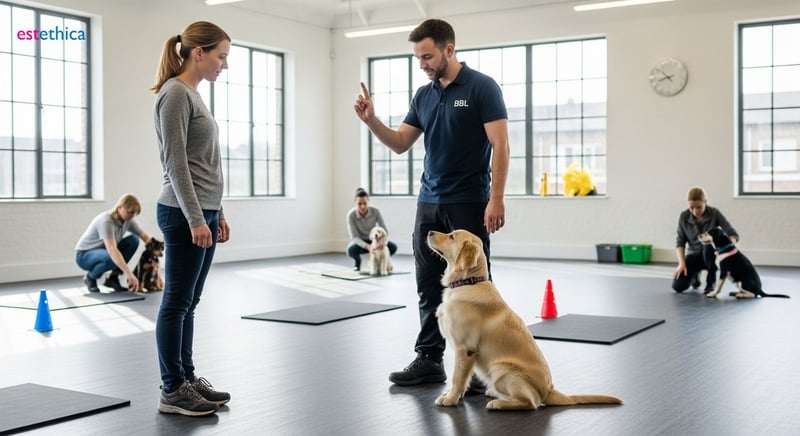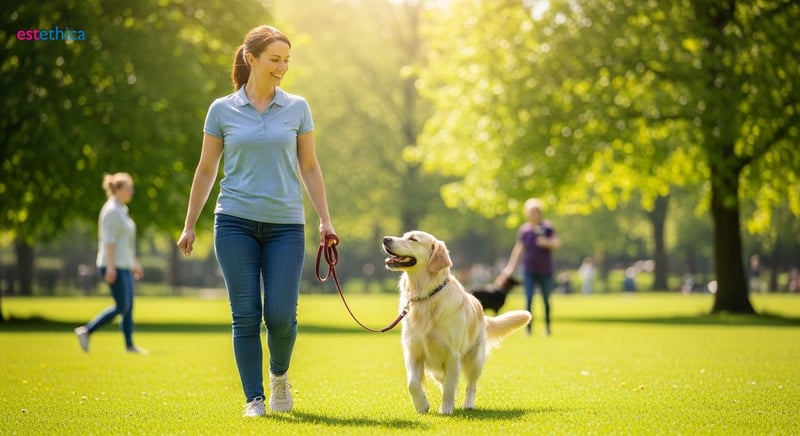Decoding Dog Behavior: Transform Your Pup with Expert Training
Explore essential dog training tips and techniques for a harmonious pet-owner relationship. Transform your puppy into a well-behaved companion.
Welcome to the ultimate guide on dog training, where unleashing your dog's potential is just the beginning. Training your canine companion is not merely about discipline but about building a harmonious relationship based on mutual respect and understanding. Whether you're a first-time puppy owner or looking to polish your pooch's skills, this guide is tailored to help you at every step.
Puppy Training 101: Setting the Foundation for a Well-Behaved Dog
Establishing a Solid Foundation in Puppy Training
Puppy training is more than just teaching tricks; it's about laying the groundwork for a lifetime of good behavior. Early training is crucial because puppies' brains are highly receptive, making it easier to instill desired behaviors. Starting early prevents the development of bad habits that can be challenging to correct later. According to the American Kennel Club, puppies should begin socialization as early as possible, ideally between 7 and 16 weeks of age, to ensure they grow into well-adjusted adults.
Begin with simple commands such as "sit," "stay," and "come." Use positive reinforcement techniques, such as treats and praise, to motivate your puppy. Keep training sessions short and fun, as puppies have short attention spans. Socialization is equally important; expose your puppy to various sights, sounds, people, and other animals in a controlled and positive manner. This helps them develop into confident and friendly dogs.
Consider enrolling in puppy training classes. These classes provide a structured environment where your puppy can learn basic commands and socialize with other dogs. A well-trained puppy is a joy to have around, and early training sets the stage for a harmonious relationship between you and your furry friend. For instance, consistent training from an early age can significantly reduce issues like excessive barking, chewing, and aggression.
Essential Commands and Socialization Techniques
- Sit: Teach your puppy to sit on command using a treat as a lure. Hold the treat above their head, moving it slightly backward, which naturally causes them to sit.
- Stay: Once your puppy knows how to sit, introduce the "stay" command. Start with short durations and gradually increase the time as they become more proficient.
- Come: Use a cheerful tone and reward your puppy with praise and a treat when they come to you. This command is crucial for safety and recall.
- Early Exposure: Introduce your puppy to different environments, such as parks, streets, and stores, to help them become comfortable in various settings.
- Controlled Interactions: Supervise interactions with other dogs and people to ensure positive experiences. Avoid overwhelming your puppy with too many new stimuli at once.
- Positive Reinforcement: Reward your puppy for calm and friendly behavior during socialization. This reinforces the desired behavior and helps them associate new experiences with positive outcomes.

Decoding Dog Behavior: Understanding the 'Why' Behind the 'Woof'
Interpreting Canine Communication Signals
Understanding dog behavior is essential for effective training. Dogs primarily communicate through body language and actions. A wagging tail doesn't always mean happiness; it can also indicate excitement or agitation. Similarly, a dog's ear position, vocalizations, and overall posture provide valuable insights into their emotional state. According to a study by the University of British Columbia, dogs have a complex range of communicative signals that humans can learn to interpret with practice.
Common behaviors like barking, chewing, and digging often stem from unmet needs or underlying stress. For example, excessive barking might be a sign of boredom or anxiety, while chewing can be a way for puppies to relieve teething discomfort or for adult dogs to alleviate stress. Digging is a natural instinct for many breeds, but it can also indicate a lack of mental stimulation. Addressing these underlying causes, rather than simply punishing the behavior, leads to more effective and lasting solutions.
Effective dog obedience begins with understanding the "why" behind the behavior. For instance, if a dog is constantly pulling on the leash, it could be due to excitement or a lack of proper training. By identifying the root cause, trainers can implement targeted strategies to modify the behavior. Similarly, if a dog exhibits aggressive behavior, understanding the triggers and addressing any underlying fear or anxiety is crucial for successful dog training.
Addressing Root Causes of Common Dog Behaviors
- Anxiety: Dogs may exhibit destructive behaviors when left alone due to separation anxiety. Providing interactive toys or creating a safe, comfortable space can help alleviate their stress.
- Boredom: Lack of mental stimulation can lead to excessive barking or digging. Engaging your dog with puzzle toys, training sessions, or regular walks can help keep them entertained and reduce unwanted behaviors.
- Fear: Dogs may react aggressively out of fear. Identifying and avoiding triggers, such as loud noises or unfamiliar people, and using positive reinforcement to build confidence can help manage fear-based behaviors.
- Observation: Pay close attention to your dog's body language and the situations in which unwanted behaviors occur. This will help you identify potential triggers and underlying causes.
- Consultation: If you're struggling to understand or manage your dog's behavior, consider consulting with a professional dog behaviorist or trainer. They can provide valuable insights and guidance.
- Patience: Modifying behavior takes time and consistency. Be patient with your dog and celebrate small victories along the way.

Positive Reinforcement: The Secret Weapon for Effective Dog Obedience
Maximizing the Impact of Reward-Based Training
Positive reinforcement involves rewarding desired behaviors, encouraging your dog to repeat them. This reward-based technique is proven to be highly effective, fostering a cooperative and eager-to-please attitude in dogs. Rewards can range from treats to verbal praise or playtime, depending on what motivates your dog the most. A consistent schedule is key, as dogs learn through repetition. Remember, patience and persistence are crucial; not all dogs learn at the same pace. According to the Association of Professional Dog Trainers, positive reinforcement is one of the most humane and effective methods for dog training.
To maximize the impact of positive reinforcement, timing is essential. Deliver the reward immediately after the desired behavior to create a clear association in your dog's mind. For example, if you're teaching your dog to sit, give the treat or praise as soon as their rear touches the ground. Vary the types of rewards to keep your dog engaged. Some dogs may be highly motivated by food, while others respond better to toys or affection.
Consistency is also key. Use the same commands and hand signals every time you ask your dog to perform a task. This reduces confusion and helps your dog learn more quickly. Remember that every dog is different, and what works for one may not work for another. Be patient and adapt your approach as needed. With consistent effort and positive reinforcement, you can achieve remarkable results in dog obedience. For instance, a dog trained with positive reinforcement is more likely to obey commands willingly and enthusiastically.
Effective Strategies for Implementing Positive Reinforcement
- Treat Variety: Use a range of treats, from small training treats to high-value rewards like bits of chicken or cheese, to keep your dog motivated and engaged.
- Verbal Praise: Combine treats with enthusiastic verbal praise, such as "Good dog!" or "Yes!" to reinforce the desired behavior and create a positive association.
- Playtime Rewards: Incorporate playtime into your training sessions as a reward for good behavior. A quick game of fetch or tug-of-war can be a great motivator for many dogs.
- Start Simple: Begin with basic commands like "sit" and "stay" and gradually increase the complexity as your dog progresses.
- Short Sessions: Keep training sessions short and frequent, ideally 5-10 minutes at a time, to maintain your dog's attention and prevent boredom.
- End on a Positive Note: Always finish training sessions with a command your dog knows well and reward them for success. This leaves them feeling confident and motivated for the next session.

Beyond the Basics: Advanced Canine Training for a Harmonious Life
Unlocking Your Dog's Potential with Advanced Training Techniques
Once your dog has mastered basic commands, it's time to advance to more complex training. This stage not only challenges your dog's intellect but also strengthens your bond. Advanced training includes agility drills, scent detection, and possibly therapy dog certification, depending on your pet’s inclination and abilities. These activities are mentally stimulating and improve your dog's confidence and physical agility, making them well-rounded companions.
Consider agility training, where dogs navigate a course of obstacles such as jumps, tunnels, and weave poles. This not only provides physical exercise but also requires focus and coordination. Scent detection is another engaging activity, tapping into a dog's natural ability to identify specific odors. This can be a fun and rewarding game, as well as a useful skill for tasks like finding lost items. Therapy dog certification involves specialized training to provide comfort and support to people in hospitals, nursing homes, or schools. According to research in Applied Animal Behaviour Science, dogs involved in advanced training show higher levels of cognitive function and adaptability.
Advanced training requires patience, consistency, and a positive attitude. Keep training sessions fun and engaging, using rewards and praise to motivate your dog. Remember to break down complex tasks into smaller, more manageable steps. Celebrate successes and don't get discouraged by setbacks. With dedication and the right approach, you can unlock your dog's full potential and enjoy a deeper, more rewarding relationship. For example, a dog trained in agility may become more confident and responsive in everyday situations.
Exploring Advanced Training Options for Enhanced Canine Skills
- Agility Training: Enroll your dog in agility classes to teach them how to navigate obstacle courses. This enhances their physical fitness, coordination, and mental focus.
- Scent Detection: Engage your dog's natural scenting abilities by hiding treats or toys and having them find them. This provides mental stimulation and strengthens their problem-solving skills.
- Therapy Dog Training: If your dog has a gentle and friendly temperament, consider therapy dog certification. This allows them to provide comfort and support to people in need.
- Start with Basics: Ensure your dog has a solid foundation in basic obedience commands before moving on to advanced training.
- Set Realistic Goals: Break down complex tasks into smaller, more manageable steps. Celebrate small victories and don't get discouraged by setbacks.
- Stay Positive: Keep training sessions fun and engaging, using rewards and praise to motivate your dog. A positive attitude is essential for success.
Positive Reinforcement Training: Achieving Effective Dog Obedience
Understanding Canine Communication for Effective Training Outcomes
Frequently Asked Questions
What are the fundamental principles of puppy training?
How does understanding dog behavior improve training outcomes?
Why is positive reinforcement considered a secret weapon in dog training?
What advanced canine training options are available beyond basic obedience?
How do dog training classes compare to training at home?
Ready for a healthier, more beautiful you?
📞 Call Now for Your Free Consultation!